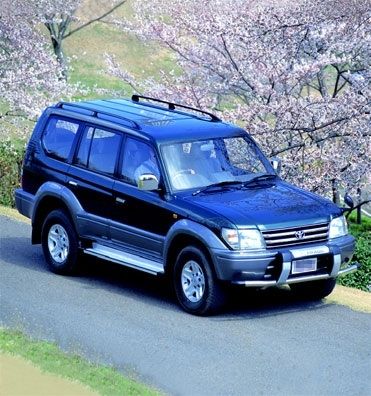Prado 90 Series marketing document from Toyota
Toyota Prado 90 Series "Mighty 90s"
For original document see attachment at end of post
MODEL 90
Surpassing Its Rivals
Demand for a 4WD with easy-to-ride characteristics naturally grew with the enhancement of user types experienced during this particular time. Gaining momentum from these demands, the Mitsubishi Pajero began to aggressively expand its market share. That was the main reason for the introduction of the 90 series Prado.

Production Period 1996-2002
Production period in Japan.
The period of introduction for this generation model may vary by region.
In 1996 the 70-series underwent a makeover and emerged as the 90-series Prado, an independent series of itself. The design was heavy duty, like the 70-series Prado, however with a smaller engine and light classification it took on the image of an underpowered 4x4, and consequently domestic sales did not do as well as expected.
The 80-series was a tough competitor in the market, boasting better performance than its rival model in the class below it, the Mitsubishi Pajero. It did not really hold a candle either to the van type series which had fully independent suspension, 3 rows of seats, driving comfort and luxury on a par with a passenger car. Even though they were in different classes by spec, the closer rival for the Mitsubishi Pajero was really the Toyota 4 Runner.
Toyota was aiming for supremacy in all classes, so it developed the 90-series Prado as its final weapon against the Mitsubishi Pajero. In addition to the standard size body there was also a wide-size body version, a sporty 3-door model as well as a 5-door model, which were all easy to distinguish from the outside. The 90-series Prado had a wide and low form, and looked amazingly similar to the Mitsubishi Pajero. Even the engine had similar specs, with two choices for the power unit, the 5VZ-FE-type gasoline engine (24-valve V6, 3,378cc, 185PS, 30.0kgm specs) and the 1KZ-TE-type diesel engine with intercooler (2,982cc, 140PS, 34.0kgm specs). The power train was a full-time 4x4, so that the lineup was clearly a front on comparison with the Mitsubishi Pajero. The Prado lineup included the KZJ90 short (diesel engine), the VZJ90 (gasoline engine), and in the long the KZJ95 (diesel engine) and the VZJ95 (gasoline engine). Like the 80-series, the long also offered a model called Active Vacation built for camping.
In this way the specs and the lineup of the 90-series Prado was a major change, but there was another secret behind its birth. Actually the 90-series Prado essentially shared the same chassis platform as the 4 Runner 185-series that had just debuted half a year before. From the time of the 70-series wagon these had shared the same type of engine, and were in a similar class. In a sense it was an inevitable response to user demand that it would take on independent suspension in the front.
This decision led to a big market success. It was featured in a television commercial, quite unusual for a 4x4, and it overtook the Mitsubishi Pajero as planned. In 1997 a new engine was added, the 3RZ-FE-type gasoline engine (DOHC in-line 4-cylinder, 2,693cc, 150PS, 24.0kgm specs), widening the variations.
In 1999 there was a fairly significant minor change introduced, with changes in the front grille, front bumper, door trim, combination meter design, and the addition of multi-reflector headlamps. In addition an Optitron meter was added, along with other luxury upgrades. Even in the mechanisms options were added which could deliver high-performance on unpaved or muddy roads, such as Active Traction Control (TRC) and Vehicle Stability Control (VSC), as well as the option for A/T in most grades.
In 2000 a newly developed diesel engine was introduced, the 1KD-FTV-type common rail type direct-injection engine with intercooler (DOHC in-line 4-cylinder, 2,982cc, 170PS, 35.9kgm specs). This was also a response to current demands for lower fuel consumption, cleaner gas emissions, less noise and vibration. Moreover, at this time also an engine immobilizer was added to all grades of the Land Cruiser as standard equipment, reflecting the problem of rising car thefts in Japanese society.
The 90-series Prado shares the same chassis platform as the 185-series 4 Runner, but the frame has greater durability than that of the Surf. The side frame on the Prado is constructed of fully closed cross-section members, and the inner channels which this forms are made of thicker steel plate. The inner channel is made of steel plates inside the side frame that reinforce and strengthen the entire frame.
The front section of the frame has the first independent suspension ever put on a Land Cruiser. Beyond this, of the 2 upper and lower arms, the upper arm is mounted in a higher position than the usual type, which strengthens the overall resistance of the suspension to horizontal G force.
Along with major changes to the suspension, the 90-series also introduced a newly developed 5VZ-FE-type gasoline engine. This 3.4-liter V6 DOHC engine with numerous technical improvements made to the cylinder heads was also more compact and lighter weight. Bringing the two camshafts closer together reduced the relative angle of the intake and exhaust valves, and as a result it was possible to create a pent roof type combustion chamber with less heat loss. Moreover, this engine was tuned for higher performance in the low- to mid- rpm range making it easier to handle.
The diesel engine in the 90-series was inherited from the 1KZ-TE-type engine of the 70-series Prado. Thanks to its compact turbo charger and air-cooled intercooler, this engine got improved output, better fuel consumption, and lower emissions. In addition, with the balance shaft and reinforced durable cylinder block there was also less noise and vibration.
As the 90-series developed new variations were added to the lineup, and more offroad 4x4 mechanisms were added. To cope with increased vehicle weight a new 4-cylinder 3RZ-FE-type gasoline engine was selected, and the 1KZ-FE-type diesel engine was replaced with a direct fuel injection 1KD-FTV-type that has greater output, lower fuel consumption, and cleaner emissions. Moreover, Active TRC was added to the drive train, which helped maintain constant delivery of drive force by automatically applying the brakes to any tire that began to spin when driving on uneven ground, enabling you to take full advantage of the existing traction in the other tires. This made the Prado both safer and more aggressive at the same time.


